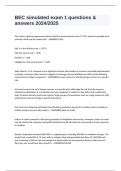BEC simulated exam 1 questions &
answers 2024/2025
The Carters signed an agreement with an effective annual interest rate of 7.74%. Interest is payable semi
annually. What was the stated rate? - ANSWERS7.60%
Add 1 to the effective rate = 1.0774
Take the square root = 1.038
Subtract 1 = .038
Multiply by 2 (for semi annual) = 7.60%
Ruby Exports, a U.S. company, has a significant amount and number of accounts receivable denominated
in foreign currencies. Ruby wants to mitigate its exchange risk and will likely use which of the following
instruments to hedge its exposure? - ANSWERSForward contract to sell the foreign currency at a specific
rate
A forward contract to sell a foreign currency at a specific price will hedge the risk that the currency
collected in satisfaction of a receivable may have weakened in relation to the dollar at the settlement
date. Forward contracts tend to be used for larger groups of transactions (such as a large volume of A/R),
while futures contracts hedge a specific transaction
One short term financing technique that effectively guarantees payment to creditors and is available to
entities trying to access trade credit is: - ANSWERSA letter of credit
Letters of credit represent a third party guarantee of obligations incurred by a company. Letters of credit
may be used by the company issuing debt (debt that would otherwise be unsecured) to ensure payment
to creditors
Barclay Corporation invested $600,000 in a capital project, including $40,000 in installation charges. The
project had a useful life of 12 years with no salvage value and generated cash flows of $150,000 each
year. Assuming a 30% tax rate and straight line depreciation for tax purposes, Barclay's after-tax cash
flows per year would have been equal to: - ANSWERS$120,000
,Pretax cash flows: $150,000
Less taxes 30%: ($45,000)
Plus tax protection on depreciation:
Capital: $600,000
Useful life: 12
Depreciation: $50,000 @ 30% = $15,000
After tax cash flows $120,000
After tax cash flows are equal to the pretax cash flows net of the tax obligations of the earnings and the
tax protection afforded through depreciation
Garter Company anticipates buying a $250,000 piece of equipment that will cost $20,000 to install, have
a nine-year useful life and generate $90,000 per year in pretax cash flows. Assuming a 30% tax rate what
is the payback period for this investment in years? - ANSWERSPayback period is computed as the net
initial investment divided by the increase in annual net after-tax cash flows. The schedule below
computes the net investment, after-tax cash flows, and payback period in years:
Computation of the net investment:
Capital investment: $250,000
Installation charges: $20,000
Net initial investment: $270,000
Annual net after-tax cash flows:
Pretax cash flows: $90,000
Less taxes @ 30% ($27,000)
Investment $270,000
Useful life: 9
Depreciation: $30,000 @ 30% = $9,000
, Pretax cash flows: $90,000
Less taxes @ 30% ($27,000)
Add depreciation: $9,000
= $72,000
Net initial investment $270,000 / $72,000 = 3.75
Cost measurement concepts include the isolation of cost objectives. Each of the items in the following
list represents a cost objective except: - ANSWERSClassification of transactions
Account classification is not a cost objective. Account classification is a bookkeeping mechanism used to
accomplish cost measurement and assignment of costs to cost objectives. A cost objective can be most
anything but, if effective, will always represent the most relevant components of a particular business'
decision making requirements
Examples of cost objectives:
Determination of net income
Efficiency measurement
Valuation of unexpired costs
In using a process cost system, a production report is usually generated that fully accounts for all units
and costs. The physical flows of units is fully accounted for by: - ANSWERSDetermining that the units in
process at the beginning of the period plus units transferred in are equal to the units transferred out plus
ending inventory
Old Kentucky Distillery produces and bottles bourbon whiskey based on a 100-year old recipe. Old
Kentucky uses process cost accounting. On the first day of the current period, the beginning work in
process value was $2.18M. During the period, 100,000 cases of bourbon were shipped, while another
10,000 cases estimated to be 50% complete remained in the distillery. During the period, Old Kentucky
recorded the following costs:
Distillery and Warehouse overhead $1.21M
Materials purchased and used: $1.0M




